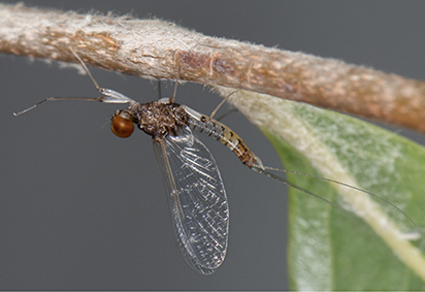Abstract
Based on material from Brazil, Colombia, and French Guiana, two new species of Paramaka are described. The male imago of Paramaka lucimarae sp. nov. can be distinguished based on the following characteristics: abdominal color pattern uniformly tinged with orangish-brown; posteromedial projection of styliger plate short and not curved; telopenis base located at apical 2/3 of penis lobe; telopenis well developed and sclerotized, crossing medially, apex slightly expanded. The male imago of Paramaka takari sp. nov. can be distinguished based on the following characteristics: abdominal color pattern contrasting (segments I and VII or VIII to X darker, II to VI or VII translucent white); black medial marks on terga restricted to the anterior ½ (posterior segments) to ¼ (anterior segments); legs yellowish-white, except for apical black band on femora; posteromedial projection of styliger plate large and slightly curved at apex; and telopenis not sclerotized. Besides describing these new species, we present updated diagnoses, illustrations, distributional maps, and a key to nymphs and adults for all the species in the genus. Data is given based on fresh material of P. convexa and P. incognita and type-material of P. antonii, P. pearljam, P. incognita, and P. froehlichi.
References
- Blanco-Belmont, L., Ruaise, V. & Peters, J.G. (2003) The nymph of Paramaka Savage & Domínguez (Ephemeroptera: Leptophlebiidae: Atalophlebiinae). In: Gaino, E. (Ed.), Research update on Ephemeroptera & Plecoptera. Università di Perugia, Perugia, pp. 117–121.
- Boldrini, R. & Barroso, P.C.S. (2015) The male imago of Paramaka incognita Domínguez, Grillet, Nieto, Molineri and Guerrero, 2014 (Ephemeroptera: Leptophlebiidae). Zootaxa, 3957 (2), 231–234. https://doi.org/10.11646/zootaxa.3957.2.7
- Coleman, C.O. (2003) Digital inking: how to make perfect line drawings on computers. Organisms, diversity & evolution, 3, 303–304. https://doi.org/10.1078/1439-6092-00081
- Coleman, C.O. (2006) Substituting time consuming pencil drawings in arthropod taxonomy using stacks of digital photographs. Zootaxa, 1360 (1), 61−68. https://doi.org/10.11646/zootaxa.1360.1.4
- Costa, S.S., Souza, F.N., Nogueira, M.A., Santos, E.P., Sousa, M.M.L., Silva, V.A., Almeida, E. & Mariano, R. (2018) Leptophlebiidae (Insecta: Ephemeroptera) from State of Bahia, Brazil. Biota Neotropica, 18 (1), 1–6. https://doi.org/10.1590/1676-0611-BN-2017-0386
- Demoulin, G. (1966) Contribution à l’étude des Ephéméroptères du Surinam. Bulletin de l’Institut Royal des Sciences Naturelles de Belgique, 42, 1–22.
- Domínguez, E., Molineri, C., Pescador, M.L, Hubbard, M.D. & Nieto, C. (2006) Ephemeroptera of South America. Aquatic Biodiversity of Latin America. Vol. 2. Pensoft Publishers, Sofia-Moscow, 646 pp.
- Domínguez, E., Grillet, M.E., Nieto, C., Molineri, C. & Guerrero, E. (2014) Ephemeroptera from the Venezuelan Guayanas’s Uplands: Families Leptophlebiidae, Euthyplociidae and Oligoneuriidae. Zootaxa, 3827 (3), 301–317. https://doi.org/10.11646/zootaxa.3827.3.1
- Eaton, A.E. (1892) Family Ephemeridae. Biologia Centrali-Americana, 38, 1–16.
- Faria, A.P.J., Rodrigues, J.A.O., Nascimento, S.R.S. & Lima, L.R.C. (2023) An updated distribution list of Leptophlebiidae Banks, 1900 (Ephemeroptera: Insecta) for Piauí state. Biota Neotropica, 23 (4), 1–6. https://doi.org/10.1590/1676-0611-BN-2023-1544
- Flowers, R.W. & Domínguez, E. (1992) New Genus of Leptophlebiidae (Ephemeroptera) from Central and South America. Annals of the Entomological Society of America, 85, 655–661. https://doi.org/10.1093/aesa/85.6.655
- Hubbard, M.D. (1982) Catálogo abreviado de Ephemeroptera da América do Sul. Papéis Avulsos de Zoologia, 34, 257–282. https://doi.org/10.11606/0031-1049.1980.34.p257-282
- Kluge, N.J. (2007) A new taxon Hermanellonota, or subtribe Hermanellini subtr.n. (Ephemeroptera: Leptophlebiidae: Hagenulini), with description of three new species from Peruvian Amazonia. Russian Entomological Journal, 16, 385–400.
- Lima, L., Knapp, W. & Docio, L. (2016) New records of mayflies (Insecta: Ephemeroptera) from Bahia State, Northeastern Brazil. Entomotropica, 31 (25), 212–220.
- Lima, M., Brasil, L.S., Juen, L., Rivera-Pérez, J.M., Dias-Silva, K. & Salles, F.F. (2023) Hermanella complex on Northern Brazil (Ephemeroptera: Leptophlebiidae): New species and stage descriptions. Revista Brasileira de Entomologia, 67 (Spe), 1–10. https://doi.org/10.1590/1806-9665-RBENT-2023-0063
- Mariano, R. (2011) A new species of Paramaka Savage & Domínguez, 1992 (Ephemeroptera: Leptophlebiidae: Atalophlebiinae) from Brazil. Zootaxa, 3038 (1), 45–50. https://doi.org/10.11646/zootaxa.3038.1.3
- Marulanda-Lopez, J.F.M., Hernández, I.C., Dias, L.G. & Salles, F.F. (2020) New, additional and historical records of Leptophlebiidae (Insecta, Ephemeroptera) from Colombia. Revista Brasileira de Entomologia, 64 (3), 1–13. https://doi.org/10.1590/1806-9665-RBENT-2020-0063
- Nascimento, S.R.S., Lima, L.R.C. & Azevêdo, C.A.S. (2020) Leptophlebiidae Banks, 1900 (Insecta, Ephemeroptera) from Maranhão state, Brazil. Check List, 16 (3), 579–591. https://doi.org/10.15560/16.3.579
- Orlando, T.Y., Salles, F.F., Boldrini, R. & Krolow, T.K. (2021) Updated records for Leptophlebiidae (Ephemeroptera) and a new species of Thraulodes Ulmer, 1920 from Tocantins State, Northern Brazil. Zootaxa, 5076 (1), 39–55. https://doi.org/10.11646/zootaxa.5076.1.6
- Polegatto, C.M. & Batista, J.D. (2007) Hydromastodon sallesi, new genus and new species of Atalophlebiinae (Insecta: Ephemeroptera: Leptophlebiidae) from West and North of Brazil, and notes on systematics of Hermanella group. Zootaxa, 1619 (1), 53–60. https://doi.org/10.11646/zootaxa.1619.1.3
- Raymundo, T.S., Martins, J.L.A., Ferreira, D.S., Gonçalves, M.C., Serrão, J.E. & Salles, F.F. (2021) The morphology of the eggs in the Hermanella complex (Ephemeroptera: Leptophlebiidae). Revista Brasileira de Entomologia, 65 (1), 1–5. https://doi.org/10.1590/1806-9665-RBENT-2020-0121
- Sartori, M. (2005) A new species of the genus Paramaka Savage & Domínguez, 1992 with some comments on related genera (Ephemeroptera, Leptophlebiidae, Atalophlebiinae). Studies on Neotropical Fauna & Environment, 40, 237–245. https://doi.org/10.1080/01650520500208481
- Salles, F.F., Dominguez, E., Mariano, R. & Paresque, R. (2016) The imagos of some enigmatic members of the Hermanella complex (Ephemeroptera, Leptophlebiidae). ZooKeys, 625, 45–66. https://doi.org/10.3897/zookeys.625.9874
- Salles, F.F., Lima, M.M. & Fernandes, O. (2021) Efemerópteros. In: Drummond, G.M., Subirá, R.J. & Martins, C.S. (Eds.), Livro vermelho da biota aquática do Rio Doce ameaçada de extinção pós-rompimento da barragem de Fundão, Mariana, Minas Gerais: crustáceos, efemerópteros, odonatos e peixes. 1st Edition. Fundação Biodiversitas, Belo Horizonte, pp. 123–174.
- Savage, H.M. & Domínguez, E. (1992) A new genus of Atalophlebiinae (Ephemeroptera, Leptophlebiidae) from northern South America. Aquatic Insects, 14 (4), 243–248. https://doi.org/10.1080/01650429209361489
- Spieth, H. (1943) Taxonomic studies on the Ephemeroptera. III. Some interesting Ephemerids from Surinam and other neotropical localities. American Museum Novitates, 1244, 1–13.
- Traver, J.R. (1960) Uruguayan mayflies. Family Leptophlebiidae: Part III. Revista de la Sociedad Uruguaya de Entomologia, 4, 73–85.
- Thomas, A., Boutonnet, J., Péru, N. & Horeau, V. (2004) Les Éphémères de la Guyane Française. 9. Descriptions d’Hydrosmilodon gilliesae n. sp. et d’H. mikei n. sp. (Ephemeroptera, Leptophebiidae). Ephemera, 4, 65–80. [2002]


